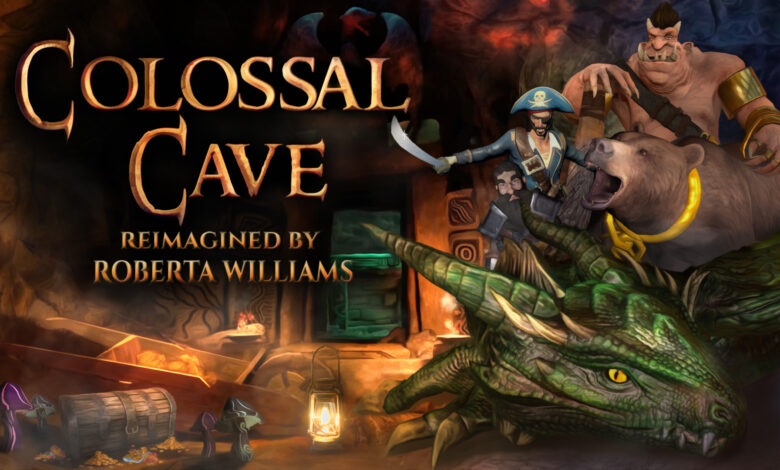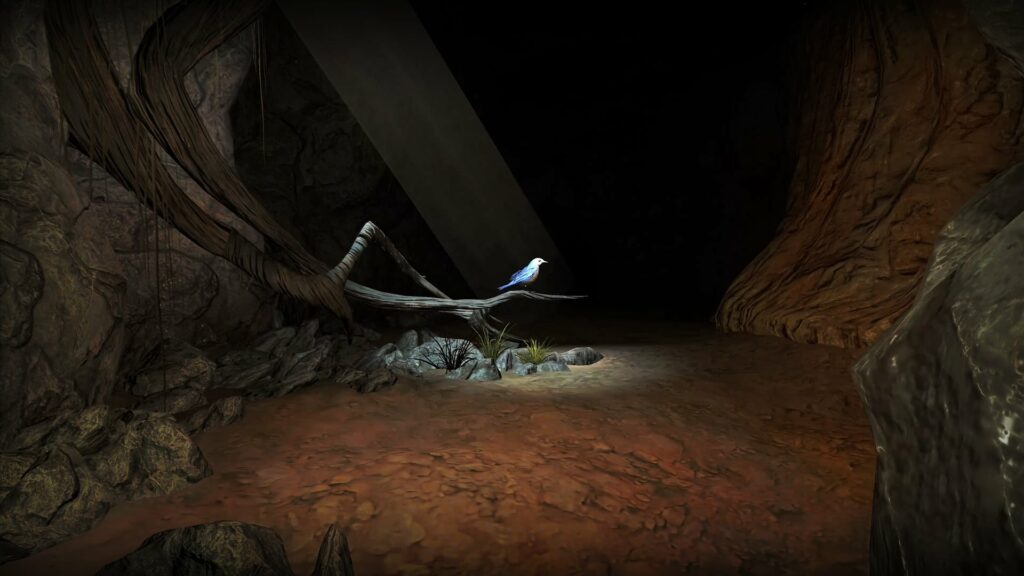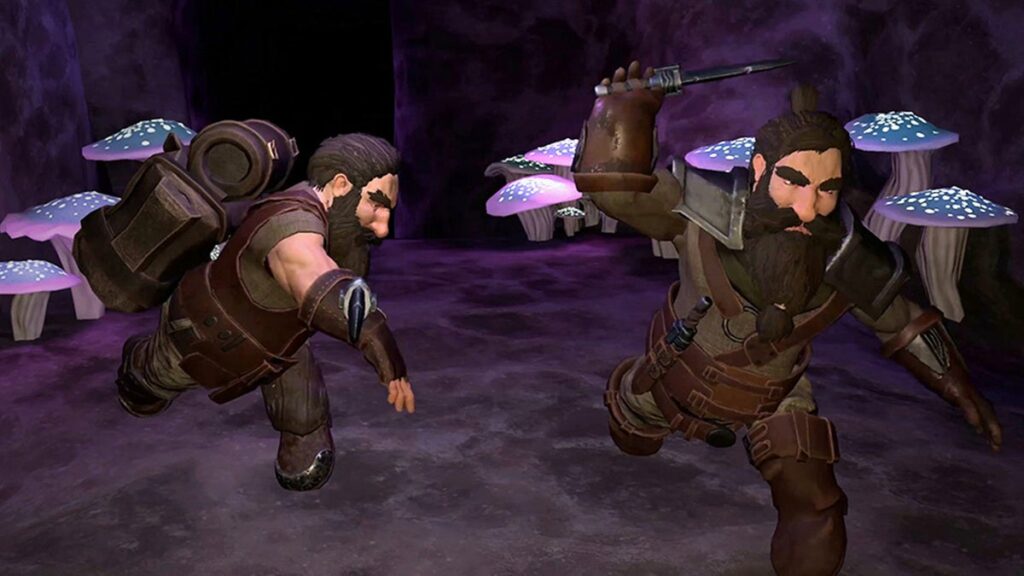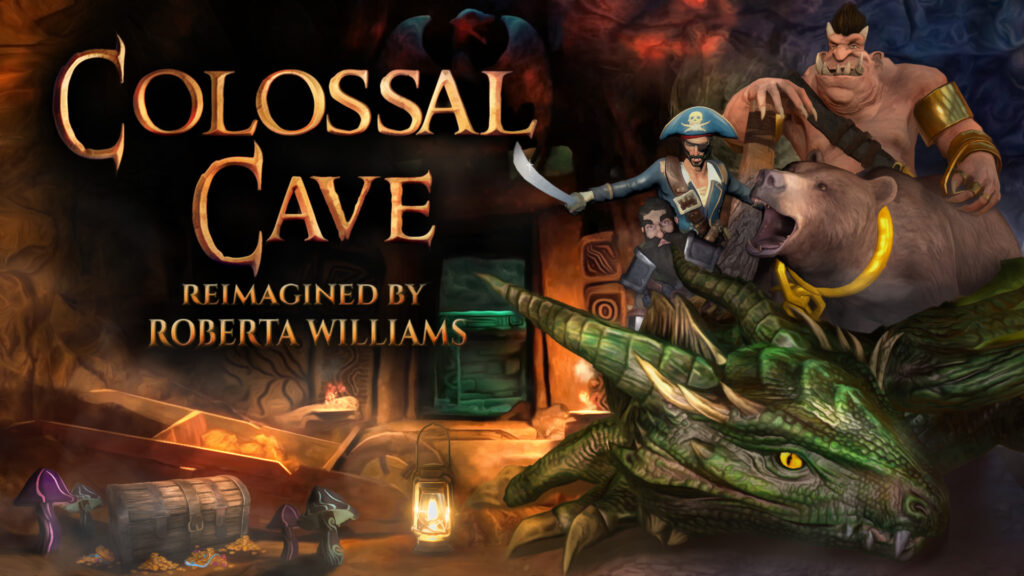Interview: Roberta Williams brings the text to life in Colossal Cave
Roberta Williams explains how the reimagined game makes real-time mechanics feel turn-based!

After selling Sierra On-Line and being away from game development for nearly three decades, we learned in March that Ken and Roberta would be making their grand return to video games by returning to their roots. With Colossal Cave 3D Adventure, the duo plan to preserve what made the original title so special, while reimagining it with 3D graphics and virtual reality compatibility.
Then, last week, we also learned that Colossal Cave – Reimagined by Roberta Williams will also hit Nintendo Switch.
Therefore, as we await the game’s fall launch for Meta Quest 2, PC and now Nintendo Switch, we at Mega Visions would like to share the next part of our exclusive interview with Ken and Roberta. In this part of our mini-series, Roberta explains how she balanced modernizing Colossal Cave to incorporate visuals, while maintaining all of the core gameplay elements from the original text adventure.
Bringing the text to life in a fully-immersive VR world
Mega Visions: As the original game was completely text-based, what is the creative process like translating that to an immersive, visual-heavy VR game?
Roberta: That, that is the hardest part. I have said to people that you would think that you have a design. It’s all designed. You know what you’re doing; you know where going. You don’t have to make up any story. And you don’t have to do anything. Just program it, and you add pictures to it.
Fairly straightforward? No, not at all. It would be easier if I had just sat down and designed my own game. To take a game, especially something that’s very historical, which this game is. Millions of people have played it. It was the first adventure game in the world. They invented it really.
You had to treat it with kid gloves, and you had to really think about how you’re going to handle this. How are you going to take a game that’s very famous and historical and treat it right? And what does that mean?
That’s been the hardest thing: what does that mean? It’s a text game. Now, not only is it going to have graphics, you’re going to be able to play it in a fully immersive 3D world. There’s on your monitor, playing it 3D there on your PC. That’s one thing, but it’s another to be on the Quest 2 for instance.
That took a lot of thought. And that is where I was pulled in at the very beginning because when I saw how they were communicating with this game, it wasn’t right; it wasn’t right at all. The interface, I didn’t like it. I put the headset on, and I never had it on my face, never experienced it ever.
So, I was thinking, “Nobody is going to play this long of a game with 3D like that.” I got dizzy. I could only do it for about five minutes, and I had to take that thing off my head. Trying to figure out the controllers, there’s standard ways on the Quest 2 to do it. Well, I didn’t know any of that stuff. I didn’t know any of it, and I didn’t feel like wanting to figure it out at this point. I didn’t like how you moved in the world. It was shimmering, and I just said, “This isn’t right.”

I had to think about how to do that. How do you translate a text game like Colossal Cave to now going to this extreme? Basically, how I started with it was I took the direction from the original designers Will Crowther and Don Woods. I sat down, and I studied this game, and I got deep into it.
I also found the original source code in Fortran, along with their design comments all through it. And I learned Fortran along the way, I think, just reading it so much. Reading their comments and looking them up where they were talking about this game, things that they said, I wanted to get into their heads.
I had to because I would find places where they made a design decision about this game and why they did it this way. Or why they did it that way. That was important for me because I was going to run into a lot of questions as to how to interpret—oh, I don’t want to give way too much of the game—but I could say, when you’re interacting with some of the characters in the game, how are we going to do that?
The dwarves . There are dwarves, and they do try to kill you. How are we going to do that? Can we talk to them? If you want to try to kill a dwarf, which you can, how are we going to handle that?
The other thing is, this game was originally turn-based. It’s the game’s turn, now it’s your turn, now it’s the game’s turn by communicating, by typing in one- or two-word sentences. Well, we’re not doing that.
Now, we have controllers. We have an interface. Or on PC, we might have a mouse and keyboard—just a multitude of ways to communicate and have an interface with this game. To take from a turn-based game to real time—you’re going through a 3D world in real time—how do you do that?
There’s no such thing, really, as turn-based. So, we had to deal with it in that way. I looked at the room descriptions that were supplied, thankfully, by the original designers. You’re now standing in front of a well-house at the end of a road in a forest. Or now you’re underneath—I don’t want to say too much—but where you are within the cave and different places.
Creating the environment one word at a time
Roberta: In some places, the designers gave me really good descriptions for me to work with the artists to recreate the way this chamber looks or how the hall looks. They had pretty good descriptions, that I would sit down with some of my key artists, especially my environmental artists, to create the environment. I’d say, “Well, they said it was like this and this and that. We have to make sure that we have it as the description said.”
The passages had to be in the right spots. We do have a compass, and you need it in this game. You do. All the passages and the exits and everything had to match up to the compass. So, we got a lot of help from the original designers.
But there are places where they didn’t give me much. They said, well you’re just in a rocky passageway. Okay? Or you’re in one of the rooms called Hall of the Mountain King, and there are five exits. And that was it. There was no description, nothing I could go by.

I got actually a little angry with them, you know? Like, couldn’t they have given me a little bit more to work with other than I’m in the Hall of the Mountain King? Well, this is where some of the interesting parts start, where you’re recreating. And I did a lot of recreations with my artists mostly at the beginning.
I said, “Now, who is the Mountain King anyway?” I mean let’s start with that. Who is that? I felt like I had to have a little bit more of a story, and they didn’t give me really a story. It’s really about exploration.
But as you play through it, and you start to get to the end, you start getting the feeling that there is a story. There’s more here than meets the eye, and you dod find out that that’s true.
But it’s not as a story, per say, that you might think of it. There’s something about it where you begin to feel that you’re not so much in a story as you are in a ride. Like maybe you’re on a tour through a funhouse in a way. So, you’re getting that sense as opposed to a story, which is also kind of like a story in a way.

In order to develop the rooms that we’re going through and the passages, we don’t want to go through one cave room after another one, after another one. You know, that’s going to get boring. I need to have more that I can work with.
So we did. We sort of made up the Hall of the Mountain King as it’s sort of part of an ancient civilization that used to live in the cave eons and eons ago. They were way more ancient than the Romans. The Romans were modern in comparison to this civilization.
So, we just call it the Hall of the Mountain King Civilization. They had their areas in there and what they were, their architecture so to speak, even though you’re in a cave. That sort of helped us.
The dwarves, they must have some sort of culture. Why are they in there? So, that is one thing that I felt compelled to do, that I had to add these components to make the game interesting with graphics. And it worked out really well.
How the gameplay stays true to the original
Roberta: Then, on the other hand, as gameplay itself, I didn’t want to touch [it]. It’s one thing to spiffy up all the graphics and add some nice touches, but it’s another thing to change the game design. I didn’t want to touch that at all.

The original game source that we found was the 350-point game that I played. I think of that as sort of the standard game. That’s what we’re using. I wanted to go back to that. I didn’t want to use any of the more recent iterations of it where there are different puzzles, more rooms, more points—I didn’t want to deal with that.
So, we are working with the original. The game’s puzzles are exactly the same; I didn’t add any. They’re exactly what they are. We use exactly the same inventory objects in exactly the same way. The scoring system is exactly the same. I didn’t put any original characters in that weren’t in the original game.
So, that’s the way I had to sort it out in my head. It is the same design, but I did have to add elements of beauty and graphics.
Colossal Cave 3D Adventure puts a creative twist on turn-based mechanics
Mega Visions: Right. So, would you sort of summarize your approach to taking everything from the original text game and filling in the blanks as needed?

Roberta: Filling in the blanks as far as stuff to see, not so much to do. Let me give you an example. In the original game, there are dwarves, and the dwarves are not nice. They will come after you and throw knives at you, and they could kill you.
I mean, even just figuring out the calculations that the original game did to kill you or you kill them. And you could kill them. You find a little dwarf axe, and you throw it at them. And there are calculations as to whether you’re going to kill them or not.
It isn’t a matter of you aiming. You’re not doing any of that because that’s not how the original game was. It was done by calculation. So, we had to figure out what the calculation is, which was in the original source.
Simulating turn-based gameplay in real-time
Roberta: But then we have to adapt it to what we’re doing because the original calculations are all turn-based. Well, we’re not turn-based because of being 3D graphics. It’s not the game goes first and then you go. It’s not like that. And it can’t be if you’re in a totally immersive 3D world virtual reality that you’re travelling through, there is no such thing as turns.
So, we had to figure out how to imitate turn-based to a certain extent. And that was Ken, how he figured that out. But it’s not exactly turn-based, but we try to emulate it as much as possible. So, then you have to relate that to you dealing with these dwarves.
They throw knives at you; then, you throw an axe. What are the chances that they’re going to kill you? They do it first. They throw a knife at you. That’s the way it is in the original game. They just pop up, and they throw.

Well, being turn-based, the way the original game was in this instance is you’re wandering through the cave, and all of a sudden, there’s a little dwarf. He throws a knife at you. That was the game’s turn.
Now, it’s my turn. Well, I could go to lunch. I could go to bed, get up in the morning, and he’s still there waiting for me if I left the game and just walked away. He’s waiting for my turn, still waiting for me to throw an axe at him. So, hours later I could throw an axe at him, and the outcome is still going to be what it was going to be by the same calculations.
That is how that worked in that type of turn-based game. Well, obviously in our game, when the dwarf throws the knife at you, and he doesn’t kill you (sometimes he does), now it’s your turn. So, how do we do that?
Is the dwarf just going to stand there, and is he going to fidget? Or is he going to look at his watch, you know? Is he going to be looking in the air or maybe tap his foot on the floor, you know, waiting for you to do something?
We actually tried that at first because I was curious to see how that would feel. So, if you’re playing the game, and you say, “Oh, I have a phone call. Oh, darn,” and you take the phone call, and you’re talking for a while, and you’re done. Well is he still there waiting for you?
We actually did that. I told the programmers and the artist to do a fidget on our dwarf and just see how that feels. Well, it felt stupid as you can imagine.
When it’s text, and he throws a knife at you, and you can throw an axe, but you got something to do in the meantime, you’re actually pretty glad when you get back and he’s still there waiting for you. But you don’t see him, and it’s a big difference when you’re looking at him.

So, we said okay, that didn’t work. So, how are we going to do this, be true to the original game and yet, not look stupid? We don’t understand how you can have a battle between a dwarf and you. I mean, that happens all the time in modern games anymore. You have to aim it and do all that.
But that’s not the way the original game was. So, how are we going to do this?
What we decided to do is we just made a timer. So, he goes first; that’s the way it works. He pops in—he poofs in—and immediately throws a knife. It’s immediately going to kill you or it’s immediately going to miss you. If it kills you, well, you know what happens then.
If it doesn’t, now what do we do? How are we going to handle this? Could you try to leave, turn and flee? Can you walk towards him? Can you talk to him? Or can you fight him? What if you don’t have an axe? What if you didn’t find it? Or what if you dropped it, and you didn’t pick it back up again? How are we going to handle this?
Establishing time-based reactions
Well, what we decided to do—and this is just one of hundreds, maybe a thousand different decisions like this—is that, I said okay. He throws a knife; he doesn’t kill you. Now, we have to have a very very short timer for you to get to your axe. Although, you could be carrying your axe around with you, nice and handy already, and we have a way of doing that.
But if you didn’t, and it’s in your inventory, you have to get to it, and you have to get it. Then, you have to come back, and you got to throw it at him. Well, we have a five-second timer. We tried a little longer one; that was too long. It begins to look dumb with him standing there.
Anything shorter than five seconds, depending on the situation—now, if you have your axe all ready to go, then we could’ve done it in about three seconds—but if you didn’t you have to go to your inventory. At your inventory, we do pause the timer. We decided to do that. You can get it, but the minute you’re back, the timer continues.
So, if you have five seconds, you’ve already used up two seconds of it figuring out to go to your inventory. It’s paused. You get your axe and come back, you only got three seconds left to do something.
And it is a point-and-click game. We figured that was the best way to do the original game. You know, I could have made it where you have to be physical, and you have to aim, and you have to do all that. But I decided not to because that’s not how the original game did it. It’s really based on calculation of whether you’re going to get him or not. And it turns out, if you want to know, nah, I’m not going to tell you. I’m not going to tell you that much.
Colossal Cave – Reimagined by Roberta Williams journeys out this fall!

Colossal Cave – Reimagined by Roberta Williams is developed and published by Cygnus Entertainment. It launches for Nintendo Switch, PC and Meta Quest 2.
You can also play the original Colossal Cave Adventure for free on Cygnus Entertainment’s official website. You can experience the game that started it all for yourselves today with the fully-embedded text game!
What do you think about Colossal Cave? Are you excited to see the game’s reimagining by Ken and Roberta Williams? Have you played the original text adventure? As always, share your thoughts with us in the comments!
And stay tuned for part three in our exclusive interview series with Ken and Roberta Williams! Over the coming weeks, you can learn even more about their journey back into game development with Colossal Cave. In case you missed it, you can also go back and check out Part One of our interview series here!

